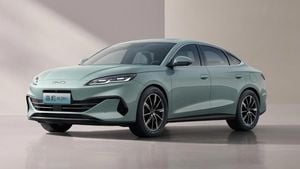NIO, the electric vehicle innovator, is making waves by integrating smartphone technology with automotive functionalities, marking the dawn of a transformative era where vehicles become extensions of our digital lives. This visionary leap isn't just about enhancing mobility; it fundamentally reshapes how we interact with both our cars and smart devices.
NIO is introducing seamless interfaces, creating synergies between smartphones and vehicles, which aims to deliver user experiences never seen before. By leaning on advanced artificial intelligence, NIO's cars sync effortlessly with smartphone platforms, offering features like remote access to car functions and intuitive voice command systems. Such integration ensures vehicles are embedded within the smart home ecosystem, allowing for greater convenience and connectivity.
The advancements don’t stop at user experience tech. NIO is also reimagining the driving experience with innovations such as augmented reality dashboards, which add interactivity to navigation systems. This approach enhances not just the functionality but the overall enjoyment of driving.
For investors scouting for opportunities within the automotive tech sector, NIO presents itself as an intriguing prospect. The company's strategic focus on marrying cutting-edge technology with sustainable EV offerings places it at the forefront of the race for carbon neutrality. Investors must, nonetheless, proceed with caution, considering the volatile nature of the EV market and varying regulatory landscapes, which could impact growth trajectories.
Looking to the future, NIO’s strategy could significantly reshape personal transportation. The company’s commitment to pushing technological boundaries may redefine how society perceives and utilizes transport, solidifying its role as a leader within the automotive revolution. But what does this integration mean for the environment?
Here's where the narrative takes another pivotal turn. The fusion of smartphones and electric vehicles not only upgrades personal mobility but poses substantial environmental benefits as well. By embracing this technological convergence, NIO is backing broader goals of reducing carbon emissions and enhancing energy efficiency.
For starters, with smartphones integrated as command centers for vehicle functions, NIO cars can optimize operational energy use. Consider the ability to remotely manage charging schedules, such as prioritizing energy extraction during off-peak hours. This feature not only helps mitigate grid pressure but also enhances renewable energy usage when available.
Further, NIO’s sophisticated app systems actively suggest efficient driving routes, minimizing energy expenditure. This contributes to lowering emissions and promoting eco-friendliness. What’s more is how user awareness grows through engagement. Drivers become more conscientious about their energy habits as they interact seamlessly with their vehicles.
Yet, the integration isn’t without its challenges. The rapid technological evolution means both smartphones and EV systems can quickly become outdated, generating electronic waste concerns. Addressing this requires thoughtful recycling strategies and sustainable production practices. Beyond e-waste, ensuring energy consumption for these advanced systems stems from renewable sources is pivotal to maintaining the environmental edge this technology promises.
NIO’s technology also invites scrutiny of its life-cycle impacts. The production of these state-of-the-art innovations often entails significant resource extraction and greenhouse gas emissions. Transparency and sustainability are now necessary cornerstones for NIO as it navigates its supply chain, aspiring to cut down these environmental costs.
The future of mobility through NIO’s innovations signals potential shifts for urban planning and smart cities, creating environments where technology not only enhances convenience but aligns with communal sustainability goals. The forthcoming years could witness this convergence cultivate smarter cities, helping redefine transportation experiences and facilitating eco-conscious communities.
The automotive giant is also acknowledging the importance of open innovation partnerships. Recent developments have unveiled NIO’s interface capabilities, which allow external services to communicate with its electric vehicles. A notable partner, Tronity, is already integrating these capabilities to offer digital fleet management solutions. Such collaborations indicate NIO's readiness to embrace the technological ecosystem needed to support this revolution.
But how does this all play out for NIO against the competitive backdrop of the EV market? The company stands out by insisting on sustainable operations and tech-forward design. While individuals now seek vehicles seamlessly integrated with digital ecosystems, they must also weigh potential cybersecurity risks against the conveniences offered.
Concerns over cost are evident with increased technology demand amplifying vehicle prices. It’s clear NIO needs to build infrastructure to facilitate comprehensive connectivity levels. Addressing these challenges is pivotal as the company navigates through intense competition and market unpredictability.
Yet, market analysts foresee growth for NIO, largely attributing its resilience to its commitment to integrating digital innovations. With the eco-conscious consumer base on the rise, NIO's environmental initiatives and green energy pursuits resonate increasingly well, positioning it for future success.
NIO’s ambition reflects broader efforts toward reducing carbon footprints through efficient manufacturing processes and renewable resource prioritization—touchstones demanding attention within the current climate debate.
Through their technological endeavors, NIO is not just enhancing personal vehicle experiences; they aspire toward lending significant support to global efforts aimed at climate change. The mobile fusion they heralds could lead to transformative societal progress, actively contributing to the future of humanity as we know it. With NIO leading the charge, the next chapter of transport innovation opens, potentially altering how we see and use vehicles altogether.



